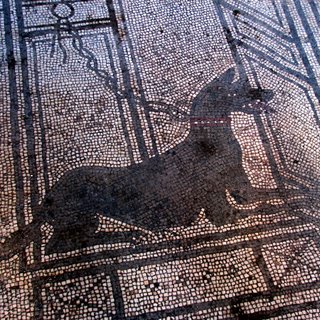
On August 29th, 79 A.D. Pompeii disappeared under a catastrophic heap of hot mud and volcanic ash. Mount Vesuvius had been threatening smoke and ash for several days and when it finally erupted a 30 foot blanket of volcanic rubble fell to earth and choked the life out of Pompeii. What had been a fully-functioning Roman city of 20,000 instead became Roman life brought to a halt.
Discovered in the 1600s, excavations didn't start until 1748 and continue still today. Pompeii is estimated to cover 164 acres with 75% officially unearthed. What you can see, and explore, is shocking for its modernity and artistic development. And also for its resemblance to the cities we all still wander today.

When you walk the streets of Pompeii, you are actually walking on paved streets. There are sidewalks and water troughs and ruts where wagons ran the road raw. There are doorways, and tiling, and political slogans crawling across walls in elongated red script. There are bakeries with ovens and large grindstone mills that once transformed wheat to flour.
Pompeii is a ghost town and you really feel the absence of its inhabitants. There are tourists - speaking every language - and the smart ones have brought a picnic lunch. (We only brought cookies and water.) But there is no one there who looks the part. No one running the flour mills. No one leading a wagon through the wheel ruts. What you feel is the absence of life and the absence of those who called this place home. This is no Williamsburg.

There is amazing art to be found in Pompeii and you get the sense that Pompeiians were great fans of art and life in general. There's a gusto lying beneath the dustiness and the sun-bleached rock. There are murals painted in vivid colors and complex mosaics with shocking detail. It's hard to believe that this city's moment in the spectrum of time was 2000 years ago. 2000 years... A lot has happened since then but as they say, a lot has stayed the same.
It's hard not to mention that the world's oldest profession was well underway 2000 years ago. There are the frescos and stone slab beds to prove it. In fact, one of the only - if not the only - buildings in all of Pompeii to be outfitted with electrical power (to aid the visitor's sightseeing abilities) is one of the brothels. The erotic illustrations above the various rooms are highly illuminated and very visible. Not all the art in Pompeii is what one might term high art. Some of it gets pretty low.

There are, though, the frescoes within the Villa of the Mysteries. This villa, slightly off the beaten path but worth the detour, features rooms brimming with color and majesty -- four walls covered in ancient storytelling and beautifully tiled floors skating along below. The art in the above room is said to depict the the initiation rite for females into the cult of Dionysus. With the marble flooring and gorgeous painting there is nothing about this place that says 2000 years ago. You spend your day re-examining your understanding and assumptions of ancient history. And wondering where, exactly, all the dogs came from.
It's the one thing I remember clearly about my visit to Pompeii with my sister over 10 years ago: the sun-stricken dogs laying all over the place. And they're still there. Just lazing about. Another thing I remember clearly is that we took a ride with an Italian family in their very small car, with its cardboard floor, to get to Pompeii. Apparently we had wandered very far off track in trying to find the main gate and this family just picked us up and took us there. You would call it hitch-hiking except we didn't ask for the ride. It just sort of happened. But I digress.
There are grand baths at Pompeii, separated into sections for women and men. There are columns and temples. Cemeteries and theaters. A giant coliseum with seats rising towards the sky. This place is complex and immense and you get exhausted wandering its streets.

There are casts of the human victims whose shapes were preserved under the ash. The faces are tormented and the bodies contorted. They are in contrast to the elegance of the art with which their lives had been surrounded, natural disaster reducing them to the basic elements once again. Its a blunt reality check. That on these streets there had been people selling their wares, walking their children, drinking their wine and then one day it all went away.
How these places have been extracted from the ash I do not know. But here they are, standing again. And standing in strength. You realize that the loss of Pompeii and its people in 79 A.D. is a gift to us today. Where else can you feel, actually touch, the way ancient Romans lived. Where can you lay a hand to the stones that paved their streets? Linger an eye along the frescos that decorated their lives?

Pompeii is one of those places. And as much as it feels old, and disturbing, and historic, it feels - at its heart - real. And this is the best part. We read history books. We hear lectures and lessons. But in Pompeii we walk Roman streets and walk through Roman doorways.
And keep a Roman eye on that volcano in the distance.

No comments:
Post a Comment